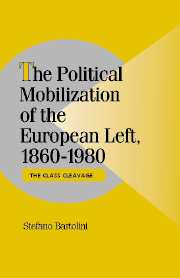Book contents
- Frontmatter
- Contents
- List of Figures and Tables
- Dedication
- Acknowledgments
- Introduction
- 1 THE CLASS CLEAVAGE: CONCEPTUAL AND METHODOLOGICAL FRAMEWORK
- 2 THE EUROPEAN LEFT: SIZE, IDEOLOGICAL ORIENTATION, AND ORGANIZATIONAL COHESION
- 3 INDUSTRIALIZATION, URBANIZATION, AND LABOR'S RESPONSE
- 4 CULTURAL HETEROGENEITY
- 5 ENFRANCHISEMENT
- 6 ORGANIZATIONAL STRUCTURING AND MEMBERSHIP MOBILIZATION
- 7 POLITICAL INTEGRATION
- 8 CLEAVAGE STRUCTURES
- 9 THE COMMUNIST SPLIT: UNITED AND DIVIDED LEFTS
- 10 THE MACROCONSTELLATION OF CLASS CLEAVAGE STRUCTURING
- DATA APPENDIX
- References
- Index
- CAMBRIDGE STUDIES IN COMPARATIVE POLITICS
9 - THE COMMUNIST SPLIT: UNITED AND DIVIDED LEFTS
Published online by Cambridge University Press: 20 October 2009
- Frontmatter
- Contents
- List of Figures and Tables
- Dedication
- Acknowledgments
- Introduction
- 1 THE CLASS CLEAVAGE: CONCEPTUAL AND METHODOLOGICAL FRAMEWORK
- 2 THE EUROPEAN LEFT: SIZE, IDEOLOGICAL ORIENTATION, AND ORGANIZATIONAL COHESION
- 3 INDUSTRIALIZATION, URBANIZATION, AND LABOR'S RESPONSE
- 4 CULTURAL HETEROGENEITY
- 5 ENFRANCHISEMENT
- 6 ORGANIZATIONAL STRUCTURING AND MEMBERSHIP MOBILIZATION
- 7 POLITICAL INTEGRATION
- 8 CLEAVAGE STRUCTURES
- 9 THE COMMUNIST SPLIT: UNITED AND DIVIDED LEFTS
- 10 THE MACROCONSTELLATION OF CLASS CLEAVAGE STRUCTURING
- DATA APPENDIX
- References
- Index
- CAMBRIDGE STUDIES IN COMPARATIVE POLITICS
Summary
In Chapter 2, the distinction between three different processes was argued: (1) working-class radicalization and revolutionary crisis; (2) short-term socialist organizational and ideological disunity; and (3) long-term communist electoral success. The radicalization of working-class politics during and after World War I, and in some places even before, was a generalized phenomenon, although the organizational and ideological strife and splits affected the national socialist movements differently according to the prewar divisions, the country's position during the war, and the socialist attitudes toward war efforts and governments. In Chapter 2, Tables 2.6, 2.7, and 2.8 have been compiled for comparative purposes, and a descriptive analysis of the level of fragmentation of the socialist movements has been made. Reference to these sections should be kept in mind while reading this chapter, which considers the overall interpretation of the long-term outcome of these processes. The explanation of the consolidation and the long-term electoral success of communism and the general constellation of forces that can explain the difference between united and divided lefts, require, in my view, a broader and more long-term interpretive framework. This problem is the central theme of this chapter.
INTERPRETATION OF COMMUNIST SUCCESS OR FAILURE
The modalities of the communist splits documented in Chapter 2 bear little relation to the more long-term electoral and organizational success of the communist movements, which instead requires a more general analysis. In three out of the four cases where communism made important electoral inroads, this took place in an unstable liberal–democratic environment. Due to the intertwining of the communist question with national integrity and independence, the party was banned in Finland for almost the entire interwar period bracketed by the two civil wars.
- Type
- Chapter
- Information
- The Political Mobilization of the European Left, 1860–1980The Class Cleavage, pp. 502 - 545Publisher: Cambridge University PressPrint publication year: 2000

